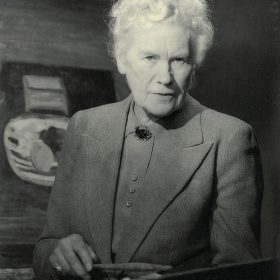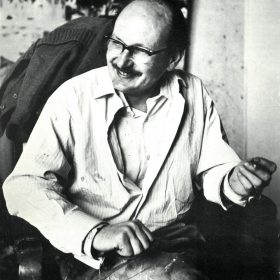Born in 1871 in Edinburgh, S. J. Peploe is the senior of the four artists known as The Scottish Colourists. He lived in Paris from 1910 until 1912, where his work changed radically from paintings reminiscent of Manet and Sargent to brilliant Fauvist works which placed him in the vanguard of British Modernism.
“My memories of S. J. Peploe are the memories of our friendship which was wonderful and interesting all the time. Nothing about it was spectacular. It was merely a happy unbroken friendship between two painters who both believed that painting was not just a craft or profession but a sustained attempt at finding a means of expressing reactions to life in the form demanded by each new experience. This is quite different from arriving at a way of doing a thing and continuing to do it in a tradesmanlike manner. By life we meant everything that happened to us; and, as we were curious about life, we painted all sorts of things – men, women, children, landscape, seapieces, flowers, still-life – anything.” Memories of Peploe, J. D. Fergusson, 1945
S. J. Peploe & The Scottish Gallery
In November 1898, the partners of Aitken Dott & Son bought the painting A Gypsy Queen by S.J. Peploe. Two years before, senior partner Peter McOmish Dott had formed The Scottish Gallery to identify the picture dealing part of the firm as distinct from the other businesses – architectural supplies, artist’s materials, framing, gilding and other services – and determined to represent the best of contemporary Scottish painting. The purchase of Peploe’s painting initiated a close relationship between the firm and the artist, then aged twenty-seven. McOmish Dott was a wholehearted admirer of Peploe’s early paintings, and a show was arranged for January 1903, which was a commercial and critical success. Peploe held a second exhibition in 1909, but from then his practice moved towards modernism and Dott struggled to accept the radical expressionist work the artist brought back from Paris after his move in 1910. However, the younger partner of the firm George Proudfoot, and subsequent directors, continued their support for the artist. From the early 1920s The Gallery held a joint contract with Alexander Reid in Glasgow to buy work directly from the artist, an arrangement that allowed Peploe to remove himself from the commercial world and concentrate on his painting, particularly his new subject of Iona and the magnificent rose and tulip paintings of his maturity. Solo exhibitions were held in 1922, 1923, 1924, 1927, 1934, 1936 (Memorial) and The Scottish Gallery has held numerous notable solo exhibitions subsequently including the artist’s 150th anniversary in 2021.
The Scottish Gallery exhibitions: 1903, 1909, 1922, 1923, 1924, 1927, 1934, 1936 (Memorial), 1947, 1985, 1990 (Edinburgh & London), 2012, 2021 (Bicentenary)















